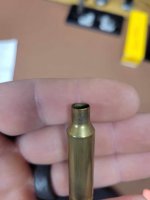Hey guys, a bit long winded but I believe in fully describing a topic or issue to prevent un-needed confusion or conversation.
I've got a re-occurring issue on my brass, of which, I have the culprit figured out but am looking for advice on the best way to remedy the effected cases.
I've got a pretty heavy inside and outside burrs that forms on the necks after wet tumbling. I'm fairly confident this is because i'm wet tumbling not once but twice. Once with dirty fired cases before re-sizing and once again after re-sizing to get the lube off. I've tried limiting the tumbler time to only an hour to see if it helped, hasn't really made a difference. Basically the case mouths are getting peened or rounded over from what I can only assume is excessive tumbling in my wet tumbler, this jives with my curious lack of needing to trim.
This burr effects my ability to expand my necks via a mandrel, as my only contact surface is the burr itself.
The burr is heavy enough that when I trim on my Henderson trimmer the inside & outside chamfer cut by the Henderson cutter isn't enough to remove the burrs completely. Easily felt with a feeler tool or fingernail. Experimenting, I ran the case over a VLD chamfer tool incrementally until the burr was gone, this leaves a knife-like edge on the case mouth which, while getting rid of my burr, it also made the case primed to peen over again in the tumbler.
I attached a picture of a fired case the has the inside burr still. It may be tough to see, i'm not sure. But even on a fired case I cannot insert a bullet until I cut away the burr. Which gets me back into the knife-edge scenario. Obviously this is negatively effecting consistency and I can feel it seating my bullets.
SO My question is, what would be the best route to cut away the burrs and my 500+ piece's of brass from this lot that have it? Without re-creating the problem down the road during the next tumbling. I was thinking an LE wilson reamer would do the job, especially since I've already got on of their trimmers and all the case holders to go with it. Any advice is welcomed. Thanks in advance!
I've got a re-occurring issue on my brass, of which, I have the culprit figured out but am looking for advice on the best way to remedy the effected cases.
I've got a pretty heavy inside and outside burrs that forms on the necks after wet tumbling. I'm fairly confident this is because i'm wet tumbling not once but twice. Once with dirty fired cases before re-sizing and once again after re-sizing to get the lube off. I've tried limiting the tumbler time to only an hour to see if it helped, hasn't really made a difference. Basically the case mouths are getting peened or rounded over from what I can only assume is excessive tumbling in my wet tumbler, this jives with my curious lack of needing to trim.
This burr effects my ability to expand my necks via a mandrel, as my only contact surface is the burr itself.
The burr is heavy enough that when I trim on my Henderson trimmer the inside & outside chamfer cut by the Henderson cutter isn't enough to remove the burrs completely. Easily felt with a feeler tool or fingernail. Experimenting, I ran the case over a VLD chamfer tool incrementally until the burr was gone, this leaves a knife-like edge on the case mouth which, while getting rid of my burr, it also made the case primed to peen over again in the tumbler.
I attached a picture of a fired case the has the inside burr still. It may be tough to see, i'm not sure. But even on a fired case I cannot insert a bullet until I cut away the burr. Which gets me back into the knife-edge scenario. Obviously this is negatively effecting consistency and I can feel it seating my bullets.
SO My question is, what would be the best route to cut away the burrs and my 500+ piece's of brass from this lot that have it? Without re-creating the problem down the road during the next tumbling. I was thinking an LE wilson reamer would do the job, especially since I've already got on of their trimmers and all the case holders to go with it. Any advice is welcomed. Thanks in advance!

